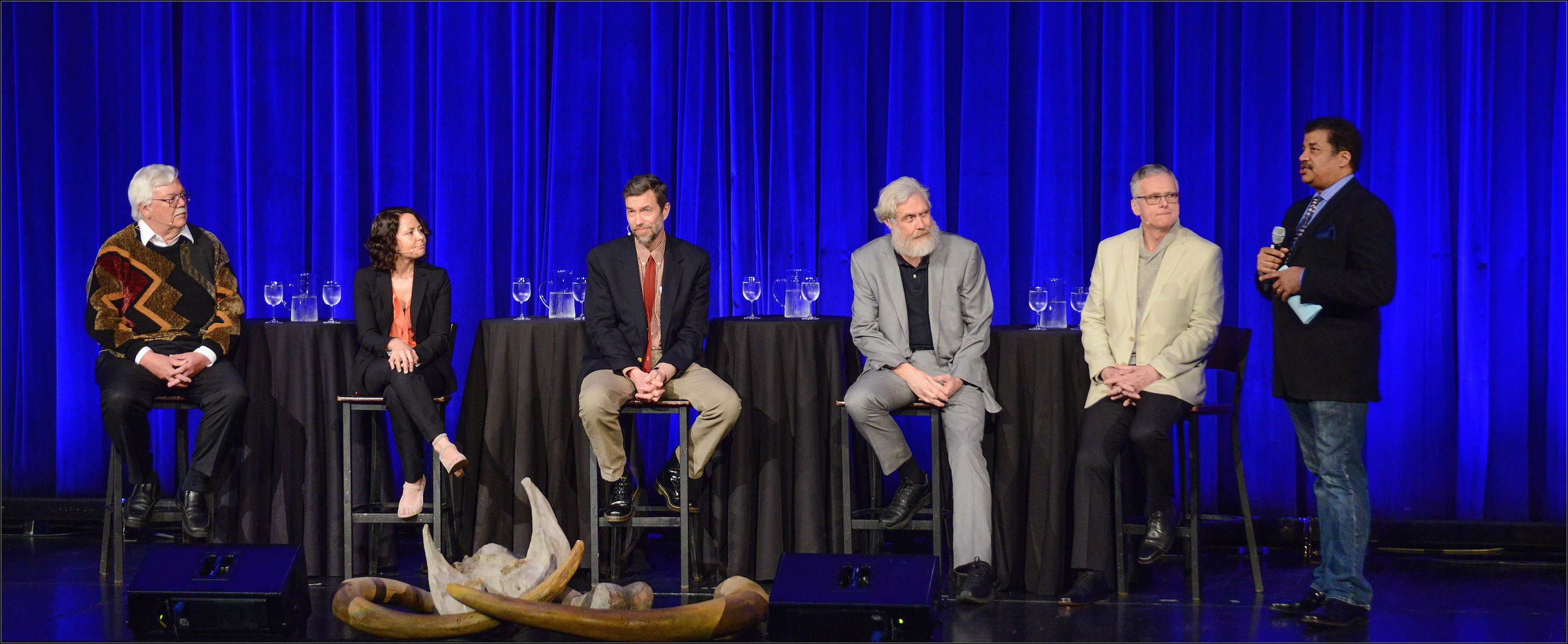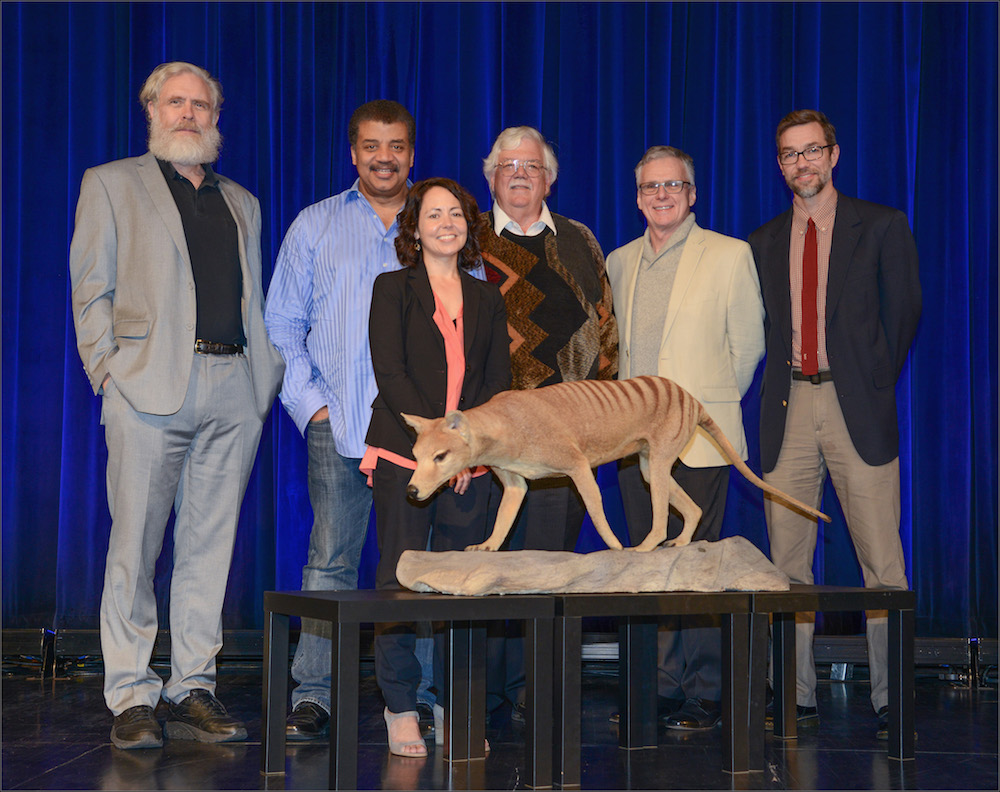Were Humans to Go Extinct, Should the Species Be Revived?

NEW YORK — If humans were to go extinct, would it be ethical to revive the species, to allow us to live once more on this blue planet?
It's a tough call, but maybe not, according to a panel of five experts who debated "de-extinction" during the annual Isaac Asimov Memorial Debate at the American Museum of Natural History (AMNH) in New York City on Wednesday (March 29). Astrophysicist Neil deGrasse Tyson, director of the AMNH Hayden Planetarium, moderated the debate, which honors Isaac Asimov (1920-1992), a biochemist and science-fiction writer who famously wrote the "three laws of robotics."
Were another intelligent life to de-extinctify humans, would they put us in a zoo-like environment? For a sentient being, that would be "extremely frightening and scary," said panelist Greg Kaebnick, a research scholar at the Hastings Center, an independent bioethics research institute in Garrison, New York. "The animal welfare concerns just get overwhelming." [6 Extinct Animals That Could Be Brought Back to Life]
Then, to further muddy the waters, Kaebnick asked, "Do we deserve to be brought back?"
Yes, we do, said panelist George Church, a professor at Harvard University and the Massachusetts Institute of Technology, who is working on reviving bits and pieces of the woolly mammoth. But then again, Church, a geneticist, molecular engineer and chemist, has often opined that the science of de-extinction is already here or within reach, and should be pursued.
The panel grappled with the issues of de-extinction for more than 2 hours, discussing not only logistics but also ethical quandaries. Logistically, scientists need an animal's entire genetic code to bring it back. But this can be a challenging task: The oldest authenticated DNA is from the bone of a 700,000-year-old horse found in Yukon, Canada, said panelist Beth Shapiro, who co-wrote a 2013 study about the horse in the journal Nature.
It's difficult to get authenticated DNA from extinct animals, even those younger than that horse, including the mammoth, thylacine (a marsupial from Tasmania that's also called the Tasmanian tiger), dodo and passenger pigeon, Shapiro said. But Church disagreed, saying that there are ways to move forward.
Get the world’s most fascinating discoveries delivered straight to your inbox.
Researchers could either find DNA in these animals' frozen nuclei, or re-create "a successful approximation" of the genome through DNA modification, Church said at a roundtable discussion later that evening.
"These are exponential technologies that improve very, very quickly and have many biomedical uses, like transplants," Church said. "I have no particular reason to doubt that we could make all of the genetic and epigenetic changes we will want to if we wanted to bring back an entire genome."
However, Church's comments were met with disbelief from some of the other panelists. Epigenetic changes are external influences on the genome that can change how much or little a gene is turned on or off, and could be difficult to modulate in a de-extinctified animal.
Lawful look
Even if the science will one day be possible, the legal framework addressing de-extinction is murky at best. If the "resurrected" animal is not a perfect copy, would it be considered the same species? Would it immediately be classified as an endangered species?
Moreover, what if its environment, microbiota (bodily bacteria) and food sources no longer exist? How many animals of a species should be brought back, so that they can have genetic diversity and mate on their own? When does human responsibility toward these revived animals end? [WipeOut: History'sMostMysteriousExtinctions]
"I think one of the toughest moral issues about de-extinction is animal welfare. How many maimed, deformed, stillborn, quasi-mammoths, quasi-elephants is it worth to bring back a sort of mammoth?" asked panelist Henry (Hank) Greely, a professor of law at Stanford University. "There are actually laws in this country, the Animal Welfare Act, that deal with some of those issues."
In addition, why not spend that money for de-extinction efforts instead on saving still-living animals, the panel asked.
De-extinction is a dangerous road, said panelist Ross MacPhee, the curator of mammalogy and vertebrate zoology at the AMNH. For instance, it's hard to know what ramifications an extinct animal will have on modern ecosystems, he said.
Rather than use science to bring back extinct animals, perhaps researchers could use these technologies to design bacteria that would help humans, for instance, by producing fuel or meat alternatives, MacPhee said. Or maybe this science could be used to insert or activate genes in plants and animals that could help them survive in an era of climate change, he added.
Some of this work is already a reality, said Church, who pointed out that scientists have made some plants more resistant to drought and pests.
Also, there have been other successful de-extinction efforts, albeit for local, not worldwide extinctions. For instance, horses used to live in North America, but went extinct at the end of the last ice age. When European explorers arrived in the New World, they inadvertently re-introduced horses to the continent, where they have since flourished.
Likewise, a fungus has rendered the American chestnut functionally extinct, meaning the species is still around (at least in lab-monitored spaces), but not in its natural environment; but scientists have tweaked the chestnut's genome to make it fungus-resistant, Greely said.
The experts agreed that this technology could also be used for evil — for instance, to bring back an extinct virus or to alter an existing virus to make it more contagious.
As this science moves forward, it's crucial to educate and involve the public, the panel said.
"We actually have to have that [discussion] to some degree, case by case, because each effort at de-extinction raises its own unique considerations," Kaebnick said.
Original article on Live Science.

Laura is the managing editor at Live Science. She also runs the archaeology section and the Life's Little Mysteries series. Her work has appeared in The New York Times, Scholastic, Popular Science and Spectrum, a site on autism research. She has won multiple awards from the Society of Professional Journalists and the Washington Newspaper Publishers Association for her reporting at a weekly newspaper near Seattle. Laura holds a bachelor's degree in English literature and psychology from Washington University in St. Louis and a master's degree in science writing from NYU.





